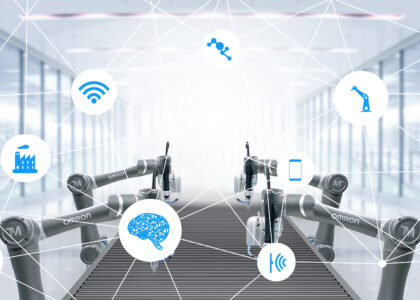INDUSTRIAL PROTOCOLS AND DIFFERENCES:
- PROFIBUS: PROFIBUS is a widely used fieldbus protocol that is primarily used for communication between industrial automation devices, such as sensors, actuators, and programmable logic controllers (PLCs). It supports both digital and analogue data transmission and is capable of handling various industrial applications. PROFIBUS uses a master-slave communication model, where one device (master) controls and communicates with multiple devices (slaves) over a serial bus.
- PROFINET: PROFINET is an Ethernet-based industrial communication protocol that combines the benefits of traditional Ethernet with real-time communication capabilities. It allows devices to communicate over standard Ethernet infrastructure while providing high-speed, deterministic data transfer for time-critical applications. PROFINET supports both real-time and non-real-time communication, making it suitable for various automation tasks.
- Foundation Fieldbus: Foundation Fieldbus is a digital communication protocol commonly used in process control applications, such as oil refineries and chemical plants. It provides communication between field devices (sensors, actuators, etc.) and control systems. Foundation Fieldbus uses a distributed architecture and supports a two-wire bus system, enabling power and data transmission over a single cable. It offers advanced diagnostic capabilities and supports both analogue and digital data transmission.
- Ethernet: Ethernet is a widely adopted networking protocol used for communication between devices within local area networks (LANs) and wide area networks (WANs). It provides a standard way for devices to transmit data packets over a network. Ethernet offers high data transfer rates, scalability, and compatibility with various devices and applications. It is commonly used in industrial settings to connect devices, such as PLCs, HMIs (Human Machine Interfaces), and other networked equipment.
- EtherCAT: EtherCAT (Ethernet for Control Automation Technology) is an industrial Ethernet protocol designed for real-time control applications. It offers high-speed, deterministic communication with low latency and is commonly used in automation systems that require precise synchronization and fast data transfer. EtherCAT uses a master-slave configuration, where the master device controls the communication between slaves in a daisy-chain topology.
- IO-Link: IO-Link is a point-to-point communication protocol used for connecting sensors and actuators to a control system. It provides a standardized interface for device communication, enabling easy integration and configuration of devices in automation systems. IO-Link allows bidirectional communication, providing device parameterization, diagnostics, and monitoring capabilities. It uses a master-slave architecture, where the master device communicates with IO-Link-enabled devices over a serial connection.
PROFIBUS VS PROFINET
PROFIBUS and PROFINET are industrial communication protocols used for automation and control, with PROFIBUS being a Fieldbus protocol and PROFINET being an Ethernet-based protocol. Foundation Fieldbus is specifically designed for process control applications. Ethernet is a general-purpose networking protocol widely used in various industries. EtherCAT is an Ethernet-based protocol optimized for real-time control applications. IO-Link is a point-to-point communication protocol for connecting sensors and actuators to control systems, offering device parameterization and diagnostic capabilities.
FOUNDATION FIELDBUS VS PROFIBUS:
Foundation Fieldbus and PROFIBUS are both industrial communication protocols, but they have some key differences. Here are the main distinctions between the two:
- Application Focus: Foundation Fieldbus is primarily used in process control applications, such as oil refineries, chemical plants, and other industries that involve continuous and batch processes. It is designed to handle complex control strategies, advanced diagnostics, and control of devices like valves, flow meters, and analyzers. On the other hand, PROFIBUS is commonly used in discrete manufacturing applications, such as factory automation, where devices like sensors, actuators, and PLCs need to communicate and coordinate their actions.
- Communication Model: Foundation Fieldbus uses a distributed communication model. It allows devices to be connected in a multidrop configuration, where multiple field devices can be connected to a single pair of communication wires (two-wire bus). This arrangement simplifies wiring and reduces the overall cabling requirements. In contrast, PROFIBUS typically uses a master-slave communication model. It involves a central master device (like a PLC) that communicates with multiple slave devices (such as sensors and actuators) over a serial bus.
- Communication Speed: PROFIBUS generally offers faster communication speeds compared to Foundation Fieldbus. PROFIBUS can achieve data transfer rates of up to 12 Mbps (megabits per second) in its high-speed variant, which is suitable for applications that require quick data exchange. Foundation Fieldbus operates at a lower data transfer rate, typically up to 31.25 kbps (kilobits per second). However, the lower speed is often sufficient for the slower dynamics and larger data packets encountered in process control.
- Data Representation: Foundation Fieldbus supports both analogue and digital data transmission. It allows for direct analogue signal transmission, which is important in process control applications where precise measurements are required. PROFIBUS, on the other hand, primarily deals with digital data transmission. It is capable of transmitting discrete values and status information between devices in the automation system.
- Diagnostic Capabilities: Foundation Fieldbus provides advanced diagnostic capabilities, allowing devices to communicate diagnostic information and status updates to the control system. It enables condition monitoring, predictive maintenance, and enhanced troubleshooting. PROFIBUS also supports diagnostics, but the level of detail and sophistication may be less extensive compared to Foundation Fieldbus.
It’s worth noting that both protocols have evolved over time, and newer versions and variants have been introduced to address specific needs and advancements in technology. The choice between Foundation Fieldbus and PROFIBUS depends on the specific application requirements, the type of devices being used, and the industry in which they are deployed.





